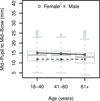The lateral brow: position in relation to age, gender, and ethnicity
- PMID: 25069068
- PMCID: PMC4114322
- DOI: 10.1097/IOP.0000000000000095
The lateral brow: position in relation to age, gender, and ethnicity
Abstract
Purpose: Despite multiple studies regarding modes of eyebrow measurement and movement over time, the lateral aspect of the brow has been relatively ignored in the literature. Therefore, we arranged a study of the most lateral aspect of the eyebrow; in doing so, we hoped to ascertain the most practical line or angle of measurement.
Methods: In this cross-sectional study, adults age 18 years and older with no history of congenital or acquired periorbital or orbital pathology or surgery, brow tattooing or heavy plucking, phthisis, or strabismus were measured using a combination of in-office metrics and computer analysis. Subjects were asked to identify their ethnicity and country of origin. Models of age, gender, and ethnicity were created.
Results: One thousand twenty-four subjects were included (1,944 eyes). Measurements of nasal ala to lateral brow (NALB), lateral brow plumb line (LBPL; the vertical line between the tail of the brow and a horizontal line extending from the lateral canthus), and angle from the midbrow to the lateral brow tail showed statistically significant decline over time. The angle and LBPL varied mostly by ethnicity. The angle narrowed approximately 3° per 20 years, while the LBPL fell approximately 2.5 mm per 20 years. The NALB varied most by age and fell approximately 3 mm per 20 years.
Conclusions: The lateral tail of the brow descends with age. Measurements of its location and rate of change vary between genders and within ethnic groups. Two easily measured values-NALB and LBPL-can be used for preoperative planning and postoperative documentation.
Conflict of interest statement
Financial conflicts of interest: None.
Figures







References
-
- Westmore M. Course presented at the Aesthetic Plastic Surgical Society Meeting. Vancouver: British Columbia; 1975. May, Facial cosmetics in conjunction with surgery.
-
- Cook TA, Brownrigg PJ, Wang TD, Quatela VC. The versatile midforehead browlift. Archives of otolaryngology--head & neck surgery. 1989;115(2):163–168. - PubMed
-
- Sclafani AP, Jung M. Desired position, shape, and dynamic range of the normal adult eyebrow. Archives of facial plastic surgery : official publication for the American Academy of Facial Plastic and Reconstructive Surgery, Inc. and the International Federation of Facial Plastic Surgery Societies. 12(2):123–127. - PubMed
-
- Feser DK, Gründl M, Eisenmann-Klein M, Prantl L. Attractiveness of eyebrow position and shape in females depends on the age of the beholder. Aesthetic Plastic Surgery. 31(2):154–160. - PubMed
-
- Cole EA, Winn BJ, Putterman AM. Measurement of eyebrow position from inferior corneal limbus to brow: a new technique. Ophthalmic Plastic and Reconstructive Surgery. 26(6):443–447. - PubMed
Publication types
MeSH terms
Grants and funding
LinkOut - more resources
Full Text Sources
Other Literature Sources
Medical

